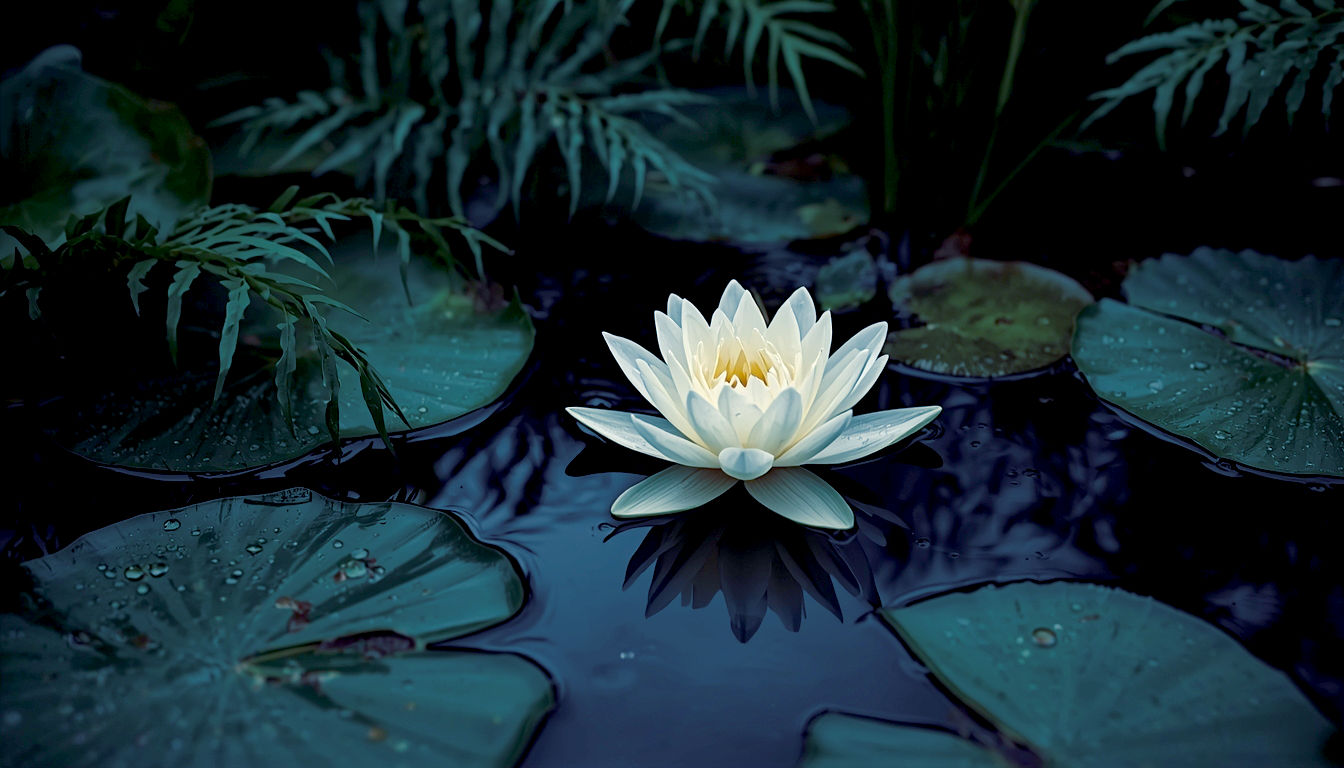The Guide to Water Lilies: Britain’s Most Serene Water Flower
Your complete guide to the water lily. Learn about hardy vs. tropical types, planting tips for the UK climate, and how they help create a healthy pond ecosystem.

This post may contain affiliate links. If you make a purchase through these links, we may earn a commission at no additional cost to you.
There’s something truly magical about a water lily. Picture a still pond on a warm summer’s day, the surface like glass, broken only by the perfect, plate-like leaves and a flower of impossible beauty resting upon it. It’s a scene straight out of a painting—and for good reason. For centuries, these floating jewels have captivated gardeners, artists, and thinkers alike. They are a symbol of peace, purity, and the quiet, unhurried beauty of nature.
But what are water lilies, really? They’re more than just pretty faces in a pond. They are ancient plants with a fascinating history, a complex biology, and a vital role to play in the health of our garden ponds and waterways. From the grand estates managed by the National Trust to the smallest backyard pond, the water lily is a quintessential part of the British waterscape.
This guide is your complete journey into their world. We’ll explore where they came from, how they work their magic, and how you can bring that same sense of wonder to your own garden. We’ll untangle the myths, demystify the science, and give you the practical, down-to-earth advice you need. Whether you’re a seasoned gardener or just someone who’s always admired them from afar, prepare to see the humble water lily in a whole new light. Let’s dive in.
What Exactly Is a Water Lily? Unpacking the Basics
At its heart, a water lily is an aquatic plant. That means it lives its life in water—specifically, in still or slow-moving freshwater like ponds, lakes, and quiet streams. They belong to a family of plants called Nymphaeaceae, a name that sounds as elegant as the flowers themselves. Think of them as the queens of the pond, reigning over their watery kingdom.
But they aren’t just floating about aimlessly. A water lily is a complex organism with distinct parts, each doing a specific job to help it thrive.
The Anatomy of a Water Lily: More Than Meets the Eye
To really understand these plants, you need to know what’s going on both above and below the water.
The Rhizome: The Engine Room Under the Mud
Hidden from view, at the bottom of the pond, is the rhizome. This isn’t a true root, but a thick, fleshy, horizontal stem that acts as the plant’s anchor and powerhouse. It creeps through the mud, storing vital nutrients and energy, much like a potato. It’s from this underground engine room that the rest of the plant grows. Think of it as the water lily’s secret weapon, allowing it to survive cold British winters and burst back into life each spring.
The Stems and Leaves: Reaching for the Sun
From the rhizome, long, flexible stems grow upwards, reaching for the sunlight. At the end of these stems are the iconic leaves, or lily pads. These aren’t just decorative plates; they are sophisticated solar panels.
- Floating Solar Panels: The top surface of the pad is waxy and green, designed to repel water and soak up as much sunlight as possible for photosynthesis—the process plants use to make food.
- Breathing Pores: The pads are covered in tiny pores called stomata, but cleverly, these are mostly on the upper surface so the plant can ‘breathe’ without getting waterlogged.
- A Perfect Design: Their round shape is brilliant for catching sunlight from all angles and helps distribute weight evenly, keeping them afloat. The characteristic notch in the pad isn’t just for looks; it helps with water drainage.
The Flower: The Star of the Show
And then there’s the flower—the reason we all fall in love with them. The flower also grows on a long stem from the rhizome, pushing its way up to bloom on or just above the water’s surface.
Water lily flowers are masterpieces of natural engineering. They are typically made up of:
- Sepals: The outer, leaf-like parts that protect the bud before it opens.
- Petals: The colourful, showy parts that attract pollinators like bees and beetles.
- Stamens: The yellow, pollen-producing parts in the centre.
- Pistil: The very heart of the flower, which receives the pollen.
The flowers have a fascinating daily routine. Many open in the morning and close in the late afternoon, a behaviour called nyctinasty. They do this for a few days before sinking back beneath the water once they’ve been pollinated, allowing their seeds to develop in peace.
Hardy vs. Tropical: Choosing Your Champion
Water lilies generally fall into two main camps: hardy and tropical. For most of us here in the UK, this is the most important distinction to understand.
Hardy Water Lilies (Nymphaea)
These are the tough cookies of the water lily world and the ones you’re most likely to see in British gardens.
- Built for Britain: They are perennials, meaning they can survive our cold winters. Their rhizomes lie dormant in the mud at the bottom of the pond, safe from the ice, ready to sprout again in spring.
- Classic Beauty: Their flowers tend to float serenely on the water’s surface. They come in a beautiful range of colours—white, pink, red, and yellow—but you won’t find blues or purples in this group.
- Day-Blooming: Their flowers open during the day, perfect for us to admire.
- Smooth Leaves: Their lily pads have smooth, even edges.
- Examples: Famous varieties include the simple and elegant white ‘Alba’ and the stunning pink ‘James Brydon’.
Tropical Water Lilies (Nymphaea)
These are the glamorous, exotic cousins. While they can be grown in the UK, they require a bit more TLC.
- Sun Worshippers: They need much warmer water (ideally above 21°C) to thrive and will die if the rhizome freezes. Gardeners in Britain usually treat them as annuals or lift the tubers in autumn to store them somewhere frost-free.
- Show-Stopping Flowers: Their flowers are often larger, more fragrant, and are held high above the water on strong stems. This is where you’ll find those incredible blues and purples, as well as vibrant pinks and whites.
- Day and Night Bloomers: Some tropical varieties are night-blooming, opening at dusk and closing in the morning, releasing a powerful fragrance to attract nocturnal pollinators like moths.
- Jagged Leaves: Their lily pads often have wavy or jagged edges.
- Example: The famous ‘King of the Blues’ is a stunning example of a tropical water lily.
For the vast majority of British ponds, hardy water lilies are the way to go. They are reliable, beautiful, and perfectly adapted to our climate.
A Journey Through Time: The Story of the Water Lily
Water lilies are not new arrivals on the plant scene. They are ancient, with fossils dating back over 65 million years, meaning they were around when dinosaurs still roamed the Earth. Their journey through history is as rich and layered as the petals of their flowers.
Ancient Roots and Sacred Symbols
Long before they graced British gardens, water lilies were revered by ancient civilisations.
The Egyptian Blue Lotus
In Ancient Egypt, the blue water lily (Nymphaea caerulea), often called the Blue Lotus, was a powerful symbol. It was associated with creation, rebirth, and the sun god, Ra. The Egyptians observed the flower’s daily cycle—closing at night and reopening in the morning—and saw it as a metaphor for life, death, and resurrection. It was depicted everywhere: in tombs, on papyrus scrolls, and as a sacred offering to the gods. They even believed its fragrance had healing and intoxicating properties.
Hindu and Buddhist Traditions
In Asia, the lotus (which is a close relative, but a different plant) and the water lily hold deep spiritual meaning in Hinduism and Buddhism. They symbolise purity, divine beauty, and spiritual enlightenment. The idea is that just as the beautiful flower rises unstained from the muddy water, so too can the human spirit rise above the muck of worldly existence to achieve nirvana.
The Water Lily Arrives in Britain
While native species like our own White Water Lily (Nymphaea alba) have always been present in our waterways, the explosion in variety and popularity in Britain really began in the 19th century.
The Victorian Plant Hunters
The Victorian era was a golden age of exploration and botany. Intrepid plant hunters travelled to the far corners of the globe, bringing back exotic specimens for the grand gardens of Britain. This is when many new species and colours of water lilies were introduced to the country.
However, the real breakthrough came from a Frenchman named Joseph Bory Latour-Marliac. He was the world’s first water lily hybridiser. Before him, gardeners only had a few colours to choose from. Starting in the 1870s, he began cross-breeding different species, and through painstaking work, he created a dazzling array of colourful, hardy hybrids—the pinks, yellows, and deep reds that we now consider classics.
Monet and the Impressionists
Latour-Marliac’s creations were a sensation. One of his most famous customers was the painter Claude Monet. Monet was so obsessed with these new, vibrant water lilies that he built a special pond for them at his home in Giverny. He then spent the last 30 years of his life painting them over and over again, in his famous Nymphéas series. These paintings cemented the water lily’s status as an icon of art and beauty, and their influence spread across the English Channel, inspiring British artists and gardeners alike.
The Giant Amazon Water Lily
Another Victorian sensation was the discovery of the Giant Amazon Water Lily (Victoria amazonica). First brought to Britain in the 1830s, its gigantic leaves—strong enough to support the weight of a child—caused a public frenzy. Joseph Paxton, the head gardener at Chatsworth House in Derbyshire, was the first to successfully cultivate and flower it in 1849. He built a special heated pool for it inside a massive glasshouse. The intricate ribbed structure of the lily pad’s underside is said to have inspired his revolutionary design for the Crystal Palace, built for the Great Exhibition of 1851.
From sacred symbol to Victorian marvel, the water lily has travelled through time, capturing human imagination wherever it has bloomed.
The Gardener’s Guide: Bringing Water Lilies to Your British Pond
There is nothing quite like the pride of seeing the first water lily bloom in your own pond. They are surprisingly easy to grow, provided you follow a few golden rules. Here’s everything you need to know to get started.
Choosing the Right Lily for Your Pond
Size matters! This is the most critical decision you’ll make. A water lily that’s too vigorous for a small pond will quickly take over, while a tiny one will get lost in a large lake. They are categorised by their size and spread:
- Pygmy/Dwarf: Perfect for container ponds, tubs, or very small water features. They need only 15-30 cm (6-12 inches) of water above their crown. Their spread is about 30-60 cm (1-2 feet).
- Great Choice: Nymphaea ‘Pygmaea Helvola’ (a lovely soft yellow).
- Small: Ideal for small to medium-sized ponds. They need 20-45 cm (8-18 inches) of water. Their spread is around 60-90 cm (2-3 feet).
- Great Choice: Nymphaea ‘James Brydon’ (a classic, cup-shaped crimson).
- Medium: Suited to medium and large ponds. They need 45-75 cm (18-30 inches) of water. Their spread is typically 1.2-1.5 metres (4-5 feet).
- Great Choice: Nymphaea ‘Gonnère’ (a stunning, peony-like white).
- Large/Vigorous: Only for very large ponds or lakes. They need 75-120 cm (30-48 inches) of water to thrive. Their spread can be 2 metres (6 feet) or more.
- Great Choice: Nymphaea ‘Gladstoniana’ (a huge, magnificent white).
Top Tip: Always check the label! It will tell you the ideal planting depth and expected spread. Don’t be tempted to put a large variety in a small pond, thinking you can control it. You can’t!
Planting Your Water Lily: A Step-by-Step Guide
The best time to plant a water lily in the UK is from late spring to early summer (May to July), when the water is warming up.
What You’ll Need:
- A water lily rhizome (bought from a reputable aquatic nursery).
- An aquatic planting basket (a mesh-sided plastic basket).
- Hessian lining (optional, but helps stop soil escaping).
- Aquatic soil (low in nutrients to prevent algae).
- Aquatic gravel.
The Planting Process:
- Prepare the Basket: If you’re using it, line the basket with a square of hessian. Fill the basket about two-thirds full with the aquatic soil.
- Position the Rhizome: Place the rhizome in the basket. For most hardy lilies, position it horizontally or at a slight angle, with the growing tip pointing towards the centre of the basket. Don’t bury it too deep; the growing tip should be just visible.
- Add More Soil: Gently add more soil around the rhizome until it’s secure, leaving a small gap at the top of the basket. Firm it down gently.
- Top with Gravel: Add a layer of aquatic gravel over the top of the soil. This is crucial—it stops the soil from washing away and prevents fish from digging up the rhizome.
- Water Thoroughly: Give the whole basket a good soaking with a watering can or hose. This helps settle everything and gets rid of any air pockets.
- Lower it into the Pond: Now for the final step. Do not just drop it straight to the bottom! The shock of the cold, deep water can be too much for a new plant. Instead, lower it in gradually. A good trick is to stand the basket on bricks or an upturned bucket so the leaves are just below the surface. As the stems grow longer over the next few weeks, you can gradually remove the bricks until the basket is at its final depth on the bottom of the pond.
Caring for Your Water Lilies: An Easy Life
Once established, hardy water lilies are wonderfully low-maintenance. Here are a few things to keep in mind.
- Sunlight: They need sun! For the best blooms, a water lily needs at least 6 hours of direct sunlight per day.
- Water Quality: They prefer still water. Avoid placing them right next to a fountain or waterfall where the splashing will constantly disturb their leaves.
- Feeding: If your flowers seem to be getting smaller after a few years, it might be time for a feed. You can push a special aquatic plant food tablet into the soil in the basket in early spring. Don’t overdo it, as this can cause algae blooms.
- Pruning: Throughout the summer, simply remove any yellowing leaves and faded flowers. Cut the stems as far down as you can reach. This keeps the plant looking tidy and encourages it to produce more flowers.
- Pests and Diseases: Water lilies are generally robust, but you might encounter a few minor issues.
- Aphids: Sometimes you’ll get little black aphids on the leaves and flowers. The easiest solution is to just blast them off with a jet of water from your hose.
- Water Lily Beetle: The larvae of this beetle can chew holes in the leaves, making them look like Swiss cheese. Again, washing them off is the best approach. In a healthy pond, fish and other wildlife will often eat the pests for you.
Dividing Your Lilies: Keeping Them Healthy
After 3-4 years, you might notice your lily is becoming congested. The leaves might be smaller and bunched up, and it might not be flowering as well. This is a sign it’s time to divide the plant.
The best time to do this is in the spring. Lift the basket out of the pond, tip the plant out, and you’ll see the tangled rhizome. Using a sharp knife, cut it into sections, making sure each piece has at least one or two healthy growing points (eyes). Discard the old, non-productive parts and replant the new sections in fresh baskets. It’s a great way to get new plants for free!
More Than Just a Pretty Flower: The Ecological Role of Water Lilies
A water lily does far more than just look beautiful. It’s a key player in creating a healthy, balanced pond ecosystem. Adding a water lily is one of the single best things you can do for the wildlife in your garden.
A Haven for Wildlife
- Shade and Shelter: The large lily pads provide crucial shade, which helps to keep the water cool in summer. This cool, shaded water is a perfect hiding place for fish, frogs, newts, and other aquatic creatures, protecting them from predators like herons and the hot midday sun.
- A Landing Pad and Hunting Ground: Dragonflies and damselflies use the pads as a place to rest, bask in the sun, and lay their eggs. Frogs love to sit on them, waiting to ambush any unsuspecting insects that fly by.
- Food Source: While we might not want them, pests like the water lily beetle provide food for fish and other pond inhabitants.
The Natural Pond Filter
Perhaps the most important job a water lily does is helping to keep the pond water clean and clear.
Fighting Algae
Algae, which turns pond water into a green soup, needs two things to thrive: sunlight and nutrients. Water lilies combat both.
- Shading Out the Sun: The lily pads float on the surface, acting like a natural parasol. By covering a portion of the pond’s surface (ideally about 50-60%), they block the sunlight that algae needs for photosynthesis. Less sun means less algae.
- Using Up Nutrients: Water lilies are hungry plants. They absorb nitrates and other nutrients directly from the water through their roots and stems. These are the same nutrients that feed algae. By using them up for their own growth, the lilies effectively starve the algae out of existence.
This natural process is far better for the environment and for wildlife than using chemical algaecides. A well-placed water lily is the greenest and most beautiful pond filter you can get.
Oxygenation (With a Twist)
Most aquatic plants release oxygen into the water, which is vital for fish. Water lilies do this too, but they also have a clever system for getting oxygen down to their rhizomes in the oxygen-poor mud. Air travels down tiny tubes in the stems of new leaves to the rhizome, and carbon dioxide from the rhizome’s respiration travels back up the stems of older leaves to be released. It’s a sophisticated internal plumbing system that allows them to thrive where other plants would struggle.
By adding a water lily, you’re not just decorating your pond; you are creating a habitat, improving water quality, and bringing a little piece of a natural ecosystem right into your back garden.
Water Lilies in Culture: Art, Myth, and Modern Britain
The water lily’s influence extends far beyond the garden wall. It has inspired artists, writers, and designers for centuries, becoming a powerful symbol in our collective culture.
A Muse for Artists
As we saw, Claude Monet’s obsession with water lilies changed the course of art. His vast, immersive paintings weren’t just pictures of flowers; they were groundbreaking studies of light, reflection, and perception. He captured the changing seasons and the time of day on the surface of his pond, with the lilies as his constant anchor.
This legacy continues today. British artists and photographers are still drawn to the graphic shapes of the lily pads and the delicate beauty of the flowers. They appear everywhere, from fine art prints to greetings cards and fabric designs, a shorthand for tranquillity and natural elegance.
A Symbol in Literature and Legend
In folklore, water lilies and their relatives are often associated with nymphs, fairies, and other water spirits. This connection gives them an air of mystery and enchantment. They appear in myths and stories as gateways to other worlds or as symbols of purity and unattainable beauty.
The Victorian “Language of Flowers” gave them a specific meaning: “purity of heart.” This made them a popular motif in the art and design of the period, from jewellery to architecture.
Water Lilies in Britain Today
Today, water lilies are an accessible part of our national heritage. You don’t have to own a grand estate to see them at their best.
- Public Gardens: Many of the UK’s most famous gardens, managed by organisations like the RHS and the National Trust, have spectacular water lily displays. The water lily houses at Kew Gardens are world-famous, showcasing the giant Victoria amazonica alongside stunning tropical varieties. Bodnant Garden in Wales and Sheffield Park in Sussex also have beautiful ponds where native and hybrid lilies thrive.
- Urban Oases: Even in our biggest cities, water lilies provide moments of peace. They can be found in the ponds of London’s royal parks, bringing a touch of wildness to the urban landscape.
- The Rise of the Garden Pond: The trend towards wildlife gardening has seen a huge resurgence in the popularity of garden ponds. For many people, a water lily is the first plant they choose—a reliable, beautiful, and eco-friendly centrepiece for their own personal nature reserve.
The Future of Water Lilies: Challenges and Innovations
What does the future hold for these ancient plants? Like much of our natural world, they face challenges, but there is also exciting innovation on the horizon.
One of the biggest threats is the spread of invasive non-native aquatic species. Plants like Floating Pennywort and Water Fern can grow at an alarming rate, choking our ponds and waterways, outcompeting native plants like our own Nymphaea alba. It’s a reminder of why it’s so important to buy plants from responsible sources and to never, ever dump unwanted pond plants into the wild.
Climate change may also present challenges, with warmer, wetter winters and hotter, drier summers potentially affecting their growth cycles and the health of our ponds.
But on the bright side, plant breeders are constantly working on new and exciting varieties. They are creating lilies that are more disease-resistant, more free-flowering, and even some that can tolerate a little more shade. There is a whole world of new colours and forms just waiting to be created, ensuring that the water lily will continue to enchant and inspire gardeners for generations to come.
A Final Thought
The water lily is so much more than just a plant. It is a living piece of history, a masterpiece of natural design, and the quiet, beating heart of a healthy pond. It teaches us about the interconnectedness of nature—how a single flower can provide food, shelter, and clean water for a whole community of creatures.
In our busy, noisy world, the water lily offers a lesson in stillness. It asks us to pause, to look closely, and to appreciate the simple, profound beauty that can rise from the most humble of beginnings. To plant a water lily is to create a moment of peace, a splash of colour, and a lasting haven for wildlife. It is one of the most rewarding things a gardener can do.
Further Reading & Resources
For those looking to delve even deeper into the world of water lilies, these highly respected British resources are an excellent place to start:
- Royal Horticultural Society (RHS): The UK’s leading gardening charity, offering expert advice on growing water lilies and other aquatic plants. Their website has detailed cultivation guides and a plant finder.
- The Wildlife Trusts: A nationwide network of conservation charities. Their website provides fantastic information on creating wildlife-friendly ponds and the ecological importance of native plants.
- BBC Gardeners’ World: A trusted source of practical, down-to-earth gardening advice, often featuring segments on pond creation and maintenance.
- National Trust: Discover some of the nation’s most beautiful and historic water gardens by visiting a National Trust property near you.






